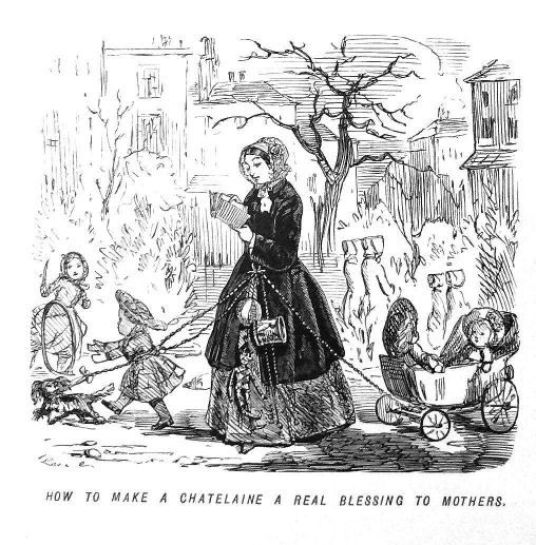“Chatelaines” … what a delicate, intriguing word. If you don’t know what they are, let your mind wander a bit and come up with your own definition. Could they be a buttery, flaky French pastry you’ve never heard of? Or perhaps, a little embroidered purse into which you’d put your loose change? Maybe, they refer to a member of a European family, perhaps third or fourth cousin, who ran off with the chambermaid. If you do know what a “Chatelaine” is, you are better informed than I. I had no idea. But these practical items were quite popular for centuries, and are still around today.
 A Chatelaine is nothing more than a “key chain” … a key chain most often worn by women heads of households, but also some men, from early Roman times through to the 19th century. During this period, women’s clothing did not have pockets, and women did not carry handbags. Unthinkable, I know. So where did women (and some men) keep the keys to the larder or the tea chest? What about those small embroidery scissors or their watch? Not to mention their snuff box or perfume vial. This very practical accessory, the Chatelaine, would hold all of these and other essential items, which a head of house, a nanny, or nurse might need at a moment’s notice.
A Chatelaine is nothing more than a “key chain” … a key chain most often worn by women heads of households, but also some men, from early Roman times through to the 19th century. During this period, women’s clothing did not have pockets, and women did not carry handbags. Unthinkable, I know. So where did women (and some men) keep the keys to the larder or the tea chest? What about those small embroidery scissors or their watch? Not to mention their snuff box or perfume vial. This very practical accessory, the Chatelaine, would hold all of these and other essential items, which a head of house, a nanny, or nurse might need at a moment’s notice.
Derived from the French word for “Keeper of the Castle” or “Mistress of the Chateau”, the Chatelaine would be affixed by a hook to a leather belt, cord or chain worn around the waist. This hook would then have a series of smaller hooks or chains hanging from it, each holding one of these essential tools. Not only were these essentials vital to the daily household chores, it was a status symbol letting others know this was a woman “in charge” and took her domestic responsibilities seriously.

Mrs. Hughes, wearing a Chatelaine, had a very prestigious and respected position as head housekeeper at Downton Abbey.
One of the most important uses of a Chatelaine was to hold a watch. With no pockets and wristwatches were not as yet invented, the need to have a watch handy was vitally important, especially if you were overseeing the running of a manor house.

Victorian Antique Chatelaine
As with most items, Chatelaines eventually became a symbol of a person’s wealth. A wealthy person might wear a very decorative and ornate Chatelaine made from precious metals and adorned with precious and semi-precious stones. As handbags became the fashion, the Chatelaine shrank in appearance and functionality, but was still a popular ornamental piece. Men began wearing them from their waistcoat to carry their watch. Women began wearing them more as a decorative accessory around their neck and even around their wrist. Perhaps this was the origin of what we now know as a “charm bracelet”.
 Punch, a very influential 19th century British weekly magazine, notorious for their sophisticated humor and satire (and is known for creating the “cartoon”), came up with an interesting use of the Chatelaine to aid mothers of young children
Punch, a very influential 19th century British weekly magazine, notorious for their sophisticated humor and satire (and is known for creating the “cartoon”), came up with an interesting use of the Chatelaine to aid mothers of young children
 As I mentioned above, Chatelaines are actually still very popular. Today’s Chatelaine may look a little different and some may be purely decorative, but not all. How many of us wear a Lanyard to hold our eyeglasses or company badge? This very practical accessory, the Lanyard, is also a modern day form of a Chatelaine.
As I mentioned above, Chatelaines are actually still very popular. Today’s Chatelaine may look a little different and some may be purely decorative, but not all. How many of us wear a Lanyard to hold our eyeglasses or company badge? This very practical accessory, the Lanyard, is also a modern day form of a Chatelaine.
You can find modern day replicas of the classic Chatelaine on Etsy or EBay, as well as department stores. But they are not only found on the runway and in fashion magazines, they are also quite popular as a ‘punk rock’ accessory in the form of a chain belt worn by both men and women, to hold wallets. Worn primarily with jeans, but they can be worn with just about any outfit. So, the name may have changed, but I believe the practicality of being able to have handy what you need, at a moment’s notice, will never loose its appeal, and if it can be decorative too, why not?
~ ~ ~ ~ ~
References: Millys Marvels, Mental Floss, Louis Dell’ Olio, Wikipedia,
_____________________________________________________________________________
